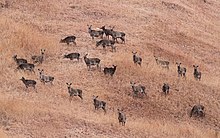Kashmir stag
| Kashmir stag | |
|---|---|

| |
| Scientific classification | |
| Domain: | Eukaryota |
| Kingdom: | Animalia |
| Phylum: | Chordata |
| Class: | Mammalia |
| Order: | Artiodactyla |
| Family: | Cervidae |
| Subfamily: | Cervinae |
| Genus: | Cervus |
| Species: | C. hanglu |
| Subspecies: | C. h. hanglu
|
| Trinomial name | |
| Cervus hanglu hanglu Wagner, 1844
| |
The Kashmir stag (Cervus hanglu hanglu), also called hangul (Kashmiri pronunciation:
Earlier believed to be a subspecies of red deer (Cervus elaphus), a number of mitochondrial DNA genetic studies later had the hangul as a part of the Asian clade of the elk (Cervus canadensis).[7][8][9][10] The IUCN and American Society of Mammalogists, however, include it in the new grouping of Central Asian red deer (Cervus hanglu), with the Kashmir stag being the type subspecies (Cervus hanglu hanglu).
Appearance
This deer has a light rump patch without including the tail. Its
Distribution and ecology

This deer lives in groups of two to 18 individuals in dense riverine forests, high valleys, and mountains of the
Threats and conservation
These deer once numbered from about 5,000 animals in the beginning of the 20th century. Unfortunately, they were threatened, due to
Much of the earlier published material was by the distinguished E. P. Gee, a member of the Bombay Natural History Society. Shortly before the expedition was mounted, Fiona Guinness and Tim Clutton-Brock, both noted deer experts, had visited Kashmir and had gathered some useful field data, which confirmed that Hangul numbers were at a dangerously low level.
The traditional breeding grounds of the hangul deer is upper danchigam, which is now occupied by Gujar shepherds and their dogs in summer.
The subspecies is battling for its survival in its last bastion: they are now scattered within 141 km2 of the
A survey in 2019 conducted by collaring the hangul has revealed that the species is no longer confined within the walls of Dachigam National Park. The endangered subspecies has now begun to use an old migratory route which spread through Sind Valley up to Tulail in Gurez Valley. The corridor was last known to be active in the early 1900s.[15]
Population
| Year | Total count | Males per 100 females | Fawns per 100 females | notes |
|---|---|---|---|---|
| 2004 | 197 | 19 | 23 | [12] |
| 2006 | 153 | 21 | 9 | [12] |
| 2008 | 127 | N/A | N/A | [12] |
| 2009 | 175 | 26 | 27 | [12] |
| 2011 | 218 | 29 | 25 | [12] |
| 2015 | 186 | 22 | 14 | [12] |
| 2017 | 214 | 16 | 19 | [12] |
| 2019 | 237 | 15.5 | 7.5 | [12] |
| 2021 | 263 | N/A | N/A | [16] |
| 2023 | 289 | N/A | N/A | [17] |
As of 2023, of the 289 Hanguls, 275 are in Dachigam National Park and 14 are in Tral Wildlife Sanctuary, which is considered as the second home of Hangul.[3]
References
- . Retrieved 12 November 2021.
- ^ "Appendices | CITES". cites.org. Retrieved 2022-01-14.
- ^ a b "{Census} Hangul population in J&K sees uptick, wildlife dept elated". Hindustan Times. 2023-08-19. Retrieved 2023-11-11.
- ^ "{Census} Hangul population in J&K sees uptick, wildlife dept elated". Hindustan Times. 2023-08-19. Retrieved 2023-11-11.
- ^ WANI, ARIF SHAFI (2023-01-16). "Hangul's disturbed corridors hampering its movement in Kashmir". Greater Kashmir. Retrieved 2023-11-11.
- ^ "What is the Kashmir Government Doing to Revive the Hangul Population?". The Wire. Retrieved 2023-11-11.
- .
- S2CID 86572236.
- PMID 15522810.
- S2CID 33193408. Archived from the original(PDF) on 2014-06-29. Retrieved 2014-08-02.
- ^ "Dachigam Management Plan pdf" (PDF). www.jkwildlife.com. Retrieved 2019-01-30.
- ^ a b c d e f g h i "Latest census shows alarming decrease in Hangul population composition". Greater Kashmir. 18 July 2019. Retrieved 23 August 2019.
- ^ "Hangul population in Kashmir has declined: JK govt". India Today.
- ^ "Most Viewed Business News Articles, Top News Articles". The Economic Times.
- ISSN 0971-751X. Retrieved 2019-02-06.
- ^ "From 127 in 2008, population of critically endangered Kashmir stag recovers to 263 in 2021". Deccan Herald. 13 November 2022. Retrieved 22 July 2023.
- ^ "{Census} Hangul population in J&K sees uptick, wildlife dept elated". Hindustan Times. 2023-08-19. Retrieved 2023-11-11.

